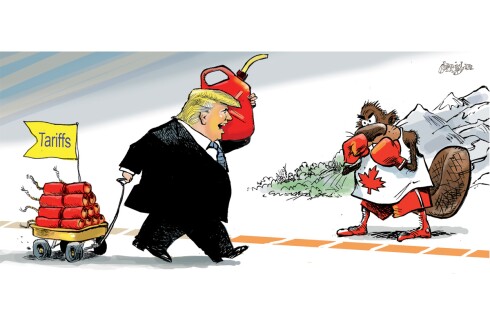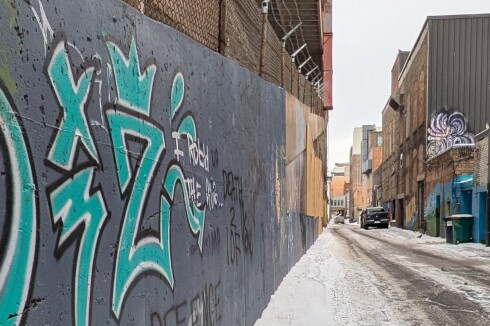In Duluth and the Northland, sex trafficking isn’t like in the movies.
There’s usually no thrashing young girl wriggling and biting to get free from a stranger dragging her away to kidnap her. International trafficking rings are about as rare in real life as a smooth street in springtime Duluth. And victims aren’t miraculously “all better” because some hero came along to say, “It’s over.”
ADVERTISEMENT
Sex trafficking here isn’t even like it has sometimes been portrayed on the News Tribune Opinion page, when editorials like this one were accompanied by illustrative photos of wrists bound by ropes, hands held up in defense, or terrified faces with eyes wide and mouths taped.
“In reality, sex trafficking looks like coercion, fraud, manipulation, and threats. These are all common tactics, way more common than kidnapping,” according to Mak Mars, a career counselor for the city of Duluth who worked nine years for PAVSA, or the Program to Aid Victims of Sexual Assault, and who spent time embedded with the Duluth Police. “In reality, most traffickers are known to their victims. They are commonly family members or partners. Most trafficking survivors don’t leave the life through stings or rescue operations.”
Last week, Mars co-hosted a webinar as part of Human Trafficking Awareness Month , which ends this week. Called “Sex Trafficking in our Community: Myth vs. Fact,” the webinar was part of a series of events throughout January meant to raise recognition and understanding of a very real problem here. Yes, it happens in Duluth and in the Northland.
Just not usually in the stereotypical ways many of us imagine.
“Traffickers hold access to the people or resources important to the victim, and that’s what keeps (victims) locked in that situation,” Mars said. “That person, you know, holds the key to their future or is their guru or is controlling their finances. It’s more than just physical. The chains that are in sex trafficking are not physical. You’re generally not going to see people running around in ropes and chains because, obviously, that’s going to draw attention.”
Rather than wearing gold chains and long fur coats, like we see on big and small screens, traffickers come from all backgrounds, genders, races, ethnicities, and walks of life. Someone who looks safe may not be. Friends can be traffickers. Community leaders and even the popular kids at school can be traffickers.
“What we see in Duluth is that it can be through intimate-partner relationships,” webinar co-host Mel Alvar of PAVSA said. “It is most commonly somebody they know … (or even) somebody in their family. … We need to be mindful and careful of trying to find, you know, the boogeyman and, ‘Be careful of the boogeyman.’ …
ADVERTISEMENT
“There’s comfort in having it be an outside boogeyman,” she acknowledged. “There’s also comfort in (the myth of) trafficking being perpetrated by strangers, (someone) other than family members, other than neighbors, and people within our own community.”
Trafficked victims are often as young as 12 to 14 years old and usually are vulnerable, including kids who are LGBTQ+, disadvantaged, insecure, or in need of housing or food.
“It’s anyone,” Alvar said. “At any time in our life, we could be in a vulnerable place.”
And targeted, either in person or online.
“Traffickers look for folks that nobody is looking for, nobody is asking about, and no one is looking out for. … They’re going to go online, where folks are gathering online. That’s … where exploitation and folks are having these grooming or recruitment-type relationships,” Alvar said. A trafficker can then use “befriending or grooming, that peer-recruitment piece, where it’s someone of the same age bringing in or someone of the same gender identity or even community or cultural background, just some kind of connection to that victim, to pull them in, to make that introduction. … There also can be violent force. We’ve seen sexual assault, rape, (and) gang rape to bring people in. And it can be intergenerational (or) where it’s just normalized in (a) family setting, and it involves family trafficking.”
While a rarity, businesses in Duluth have served as fronts for sexual exploitation, including small, independent massage parlors and a candy shop in 2007, Alvar and Mars reported. The Duluth-Superior port has also been a point of exploitative activity, though not since tightened security measures following 9/11.
In Minnesota, the Native American community is especially vulnerable; between 27 and 54 American Indian women and girls are missing in any given month, a 2020 Missing and Murdered Indigenous Women Task Force report to the Minnesota Legislature determined. In addition, among trafficking survivors receiving services in Minnesota, nearly 75% were Black, Indigenous, or people of color (BIPOC), according to the Minnesota Office of Justice Programs and Minnesota Statistical Analysis Center.
ADVERTISEMENT
Every month in Minnesota, more than 10,000 ads are posted online selling victims for sex, the Minnesota Bureau of Criminal Apprehension reported in 2022.
“It's never OK to buy another person for sex,” BCA Superintendent Drew Evans said at the time. “We all must work together to bring sex trafficking to an end in Minnesota."
Despite years of awareness, and not just in January, the public health and humanitarian crisis that is trafficking hasn’t been ended, however. Far from it. It may just look a little different than it once did or how we imagine. Our vigilance demands to be continued.
















